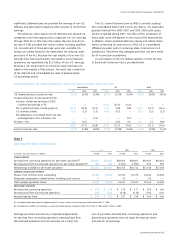GE 2006 Annual Report Download - page 79
Download and view the complete annual report
Please find page 79 of the 2006 GE annual report below. You can navigate through the pages in the report by either clicking on the pages listed below, or by using the keyword search tool below to find specific information within the annual report.
We amortize the cost of other intangibles over their estimated
useful lives unless such lives are deemed indefi nite. Amortizable
intangible assets are tested for impairment based on undiscounted
cash flows and, if impaired, written down to fair value based
on either discounted cash flows or appraised values. Intangible
assets with indefinite lives are tested annually for impairment
and written down to fair value as required.
GECS investment contracts, insurance liabilities and
insurance annuity benefits
Certain SPEs, which we consolidate, provide guaranteed invest-
ment contracts to states, municipalities and municipal authorities.
Our insurance activities also include providing insurance and
reinsurance for life and health risks and providing certain annuity
products. Three product groups are provided: traditional insurance
contracts, investment contracts and universal life insurance
contracts. Insurance contracts are contracts with signifi cant
mortality and/or morbidity risks, while investment contracts are
contracts without such risks. Universal life insurance contracts
are a particular type of long-duration insurance contract whose
terms are not fixed and guaranteed.
For short-duration insurance contracts, including accident and
health insurance, we report premiums as earned income over the
terms of the related agreements, generally on a pro-rata basis.
For traditional long-duration insurance contracts including term,
whole life and annuities payable for the life of the annuitant, we
report premiums as earned income when due.
Premiums received on investment contracts (including annui-
ties without significant mortality risk) and universal life contracts
are not reported as revenues but rather as deposit liabilities.
We recognize revenues for charges and assessments on these
contracts, mostly for mortality, contract initiation, administration
and surrender. Amounts credited to policyholder accounts are
charged to expense.
Liabilities for traditional long-duration insurance contracts
represent the present value of such benefits less the present value
of future net premiums based on mortality, morbidity, interest
and other assumptions at the time the policies were issued or
acquired. Liabilities for investment contracts and universal life
policies equal the account value, that is, the amount that accrues
to the benefit of the contract or policyholder including credited
interest and assessments through the financial statement date.
Liabilities for unpaid claims and claims adjustment expenses
represent our best estimate of the ultimate obligations for
reported and incurred-but-not-reported claims and the related
estimated claim settlement expenses. Liabilities for unpaid claims
and claims adjustment expenses are continually reviewed and
adjusted through current operations.
Accounting changes
We adopted Financial Accounting Standards Board (FASB)
Statement of Financial Accounting Standards (SFAS) 123 (Revised
2004), Share-Based Payment (SFAS 123R) and related FASB Staff
Positions (FSPs), effective January 1, 2006. Among other things,
SFAS 123R requires expensing the fair value of stock options,
a previously optional accounting method that we adopted
voluntarily in 2002, and classification of excess tax benefi ts
associated with share-based compensation deductions as cash
from financing activities rather than cash from operating activities.
We chose the modified prospective transition method, which
requires that the new guidance be applied to the unvested portion
of all outstanding stock option grants as of January 1, 2006, and
to new grants after that date. We further applied the alternative
transition method provided in FSP FAS 123(R) –3, Transition
Election Related to Accounting for the Tax Effects of Share-Based
Payment Awards. The transitional effects of SFAS 123R and
related FSPs consisted of a reduction in net earnings of $10 million
for the year ended December 31, 2006, to expense the unvested
portion of options granted in 2001; and classification of $173 million
related to excess tax benefits from share-based compensation
deductions as cash from financing activities in our Statement of
Cash Flows beginning in 2006, which previously would have
been included in cash from operating activities.
A comparison of reported net earnings for 2006, 2005 and
2004, and pro-forma net earnings for 2005 and 2004, including
effects of expensing stock options, follows.
(In millions; per-share amounts in dollars) 2006 2005 2004
Net earnings, as reported $20,829 $16,711 $17,160
Earnings per share, as reported
Diluted 2.00 1.57 1.64
Basic 1.65
Stock option expense
included in net earnings
2.01 1.58
96 106 93
Total stock option expense(a) 96 191 245
PRO-FORMA EFFECTS
(b)
Net earnings, on pro-forma basis 16,626 17,008
Earnings per share, on pro-forma basis
Diluted 1.57 1.63
(b)
(b)
Basic 1.57 1.64
Other share-based compensation expense recognized in net earnings amounted to
$130 million, $87 million and $95 million in 2006, 2005 and 2004, respectively.
The total income tax benefit recognized in earnings for all share-based compensation
arrangements amounted to $117 million, $115 million and $101 million in 2006, 2005
and 2004, respectively.
(a) As if we had applied SFAS 123R to expense stock options in all periods. Included
amounts we actually recognized in earnings.
(b) Not applicable. As of January 1, 2006, total stock option expense is included in
net earnings.
SFAS 158, Employers’ Accounting for Defi ned Benefi t Pension
and Other Postretirement Plans, became effective for us as of
December 31, 2006, and requires recognition of an asset or
liability in the statement of financial position reflecting the funded
status of pension and other postretirement benefit plans such as
retiree health and life, with current-year changes in the funded
status recognized in shareowners’ equity. SFAS 158 did not
change the existing criteria for measurement of periodic benefi t
costs, plan assets or benefi t obligations.
ge 2006 annual report 77
























